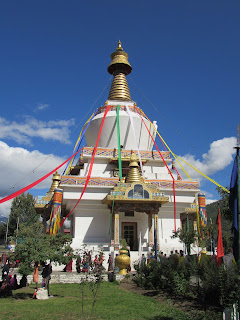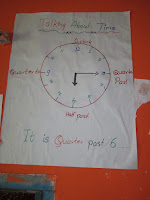This was our day to travel back to Paro so that we could try to hike up to the Tiger’s Nest. But first we would stop at the archery field in Thimphu to see more of the national archery competition. Two teams were competing – Bhutan Nexen Tyres and Karma Auto. Interestingly, a squad of eight cheerleaders in traditional Bhutanese attire would stand next to the competitors. When someone from the losing team was shooting, the cheerleaders would sing a quiet, soothing song. On the other hand, when someone from the winning team was shooting, the cheerleaders would sing a harsh, heckling tune and would wave their scarves in his direction. A referee would stand nearby to make sure their scarves did not actually touch the archer. It took a lot of concentration for the archer to get off a good shot with the cheerleaders in his face. After about 15 minutes of this, we hopped on the bus and drove toward Paro.
The route was familiar from three
days earlier, but we drove at a more leisurely pace. The crew was no longer
clearing the landslide, although the path through the slide was only one lane
wide. We stopped at the confluence of the Paro and Thimphu rivers, where three
stupas had been built, one in Nepali style, one in Tibetan style, and one in
Bhutanese style. It was a beautiful spot with pay toilets and handicrafts for
sale. A plaque announced that the modern bridge had been completed in 1990.
Next we drove to an old chain
pedestrian bridge over the Paro River. The bridge, now closed, had substantial
gate houses on either end and was bedecked with prayer flags. A new concrete
and steel pedestrian suspension bridge led to a monastery on a hill on the
other side of the river. In front of the monastery, the monks were leading a
ceremony that included monks and others.
 Our driver took us through
downtown Paro and across the river to the National Museum of Bhutan. The museum
had been located in a watchtower built in 1649 by the first governor of Paro
valley. Its architectural style is the same as the Paro dzong located just
downhill and closer to town. The watchtower was damaged in a recent earthquake
and was still undergoing reconstruction. The museum exhibits were confined to a
modern building located next door.
Our driver took us through
downtown Paro and across the river to the National Museum of Bhutan. The museum
had been located in a watchtower built in 1649 by the first governor of Paro
valley. Its architectural style is the same as the Paro dzong located just
downhill and closer to town. The watchtower was damaged in a recent earthquake
and was still undergoing reconstruction. The museum exhibits were confined to a
modern building located next door.
The museum included exhibits
about the geology, flora and fauna of Bhutan. Abby pointed out the skin of a
crocodilian reptile that hung on the wall. Like Nepal, southern Bhutan is
subtropical, while in the north are the Himalayas. There’s quite a range of different
biomes. No photographs were allowed. There were also some historical artifacts
such as masks, thangka paintings, religious statuary and clothing. It was an
interesting museum, though necessarily smaller than it would have been if the
watchtower were open.
 We at lunch at Lhayabling
Restaurant on the second floor of a building in downtown Paro. It was the usual
buffet of stir-fried chicken and stir-fried vegetables. The chilies and cheese
concoction used to flavor the rice included potatoes, which was different from
what we had had in Thimphu. Below the restaurant, on the ground floor, was a
gift shop where Abby found a set of sandalwood prayer beads that she liked. The
shop’s clerk added the seven metallic counters to the prayer beads that seem to
be unique to Bhutan.
We at lunch at Lhayabling
Restaurant on the second floor of a building in downtown Paro. It was the usual
buffet of stir-fried chicken and stir-fried vegetables. The chilies and cheese
concoction used to flavor the rice included potatoes, which was different from
what we had had in Thimphu. Below the restaurant, on the ground floor, was a
gift shop where Abby found a set of sandalwood prayer beads that she liked. The
shop’s clerk added the seven metallic counters to the prayer beads that seem to
be unique to Bhutan.  We checked in at the Tashi Namgay
Resort, where we stayed in semi-detached villas along the river. John and
Pauline were in the other half of the villa we were in. The sound of the
rushing water was a soothing relief after the nocturnal barking dogs of
Thimphu. We gathered at 5:45 p.m., just before supper, for a briefing about
tomorrow’s attempt to hike to the Tiger’s Nest, which is more formally known as
the Taktsang monastery. Guru Rimpoche, who brought Buddhism to Tibet, is said
to have landed there on the back of a flying tigress in the 8th
century. The monastery, built on the edge of a cliff that drops straight down
for 3000 feet, was built in the 17th century. The monastery lies at
10,000 feet above sea level, and the hike starts at 8,000 feet. As hikers, we
would attempt to hike three miles up the mountain over the 2000-foot change in
elevation and then back down again. It would be challenging.
We checked in at the Tashi Namgay
Resort, where we stayed in semi-detached villas along the river. John and
Pauline were in the other half of the villa we were in. The sound of the
rushing water was a soothing relief after the nocturnal barking dogs of
Thimphu. We gathered at 5:45 p.m., just before supper, for a briefing about
tomorrow’s attempt to hike to the Tiger’s Nest, which is more formally known as
the Taktsang monastery. Guru Rimpoche, who brought Buddhism to Tibet, is said
to have landed there on the back of a flying tigress in the 8th
century. The monastery, built on the edge of a cliff that drops straight down
for 3000 feet, was built in the 17th century. The monastery lies at
10,000 feet above sea level, and the hike starts at 8,000 feet. As hikers, we
would attempt to hike three miles up the mountain over the 2000-foot change in
elevation and then back down again. It would be challenging.












































